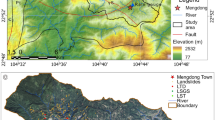Abstract
Koshi River basin, which lies in the Central Himalayas with an area of 71,500 km2, is an important trans-boundary river basin shared by China, Nepal and India. Yet, landslide-prone areas are all located in China and Nepal, imposing alarming risks of widespread damages to property and loss of human life in both countries. Against this backdrop, this research, by utilizing remote sensing images and topographic maps, has identified a total number of 6877 landslides for the past 23 years and further examined their distribution, characteristics and causes. Analysis shows that the two-step topography in the Himalayan region has a considerable effect on the distribution of landslides in this area. Dense distribution of landslides falls into two regions: the Lesser Himalaya (mostly small and medium size landslides in east-west direction) and the Transition Belt (mostly large and medium size landslides along the river in north-south direction). Landslides decrease against the elevation while the southern slopes of the Himalayas have more landslides than its northern side. Change analysis was carried out by comparing landslide distribution data of 1992, 2010 and 2015 in the Koshi River basin. The rainfall-induced landslides, usually small and shallow and occurring more frequently in regions with an elevation lower than 1000m, are common in the south and south-east slopes due to heavy precipitation in the region, and are more prone to the slope gradient of 20°~30°. Most of them are distributed in Proterozoic stratum (Pt3ε, Pt3 and Pt2-3) and Quaternary stratum. While for earthquake-induced landslides, they are more prone to higher elevations (2000~3000 m) and steeper slopes (40°~50°).
Similar content being viewed by others
References
Bookhagen B, Burbank DW (2010) Toward a complete Himalayan hydrological budget: Spatiotemporal distribution of snowmelt and rainfall and their impact on river discharge. Journal of Geophysical Research 115(F3). DOI: 10.1029/2009JF001426.
Chakraborty D, Anbalagan R (2013) Landslide hazard analysis and management: A case study from Nainital, India. Earth System Processes and Disaster Management, Society of Earth Scientists Series 1. DOI: 10.1007/978-3-642-28845-6_11.
Chen N, Hu G, Deng W, et al. (2013) On the water hazards in the trans-boundary Koshi river basin. Natural Hazards and Earth System Sciencs 13: 795–808. DOI: 10.5194/nhess-13-795-2013.
Chengdu geological survey center of China Geological Survey (2007) Geological Map of Qinghai Tibet Plateau and Its Adjacent Area. Geological Publishing House, Beijing, China.
Cui P, He S, Wang Z, et al. (2011) Formation mechanism and risk control to mountain hazards induced by Wenchuan earthquake. Science Press, Beijing, China.
Dahal RK, Hasegawa S (2008) Representative rainfall thresholds for landslides in Nepal Himalaya. Geomorphology 100: 429–443. DOI: 10.1016/j.geomorph.2008.01.014.
Dahal RK, Hasegawa S, Yamanaka M, et al. (2006) Rainfall triggered flow-like landslides: understanding from southern hills of Kathmandu, Nepal and northern Shikoku, Japan. Proc 10th Int Congr of IAEG, The Geological Society of London, IAEG2006 Paper number 819, 1–14.
Dahal RK, Hasegawa S, Nonomura A, et al. (2008) Predictive modeling of rainfall-induced landslide hazard in the Lesser Himalaya of Nepal based on weights-of-evidence. Geomorphology 102: 496–510. DOI: 10.1016/j.geomorph. 2008.05.041.
Dahal RK, Hasegawa S, Yamanaka M, et al. (2009) Comparative analysis of contributing parameters for rainfall-triggered landslides in the Lesser Himalaya of Nepal. Environmental Geology 58: 567–586. DOI: 10.1007/s00254-008-1531-6.
Dahal RK, Bhandary NP, Timilsina M, et al. (2013) Earthquakeinduced landslides in the roadside slopes of east Nepal after recent September 18, 2011 earthquake. Earthquake-Induced Landslides. Springer Berlin Heidelberg, pp 149–157.
Dai F, Xu C, Yao X, et al. (2011) Spatial distribution of landslides triggered by 2008 Ms 8.0 Wenchuan earthquake, China. Journal of Asian Earth Sciences 40(4): 883–895. DOI: 10.1016/j.jseaes.2010.04.010
Deoja BB, Dhital MR, Thapa B, et al. (1991) Mountain risk engineering hand book. International Centre for Integrated Mountain Development, Kathmandu, Nepal.
Dhital MR, Khanal N, Thapa KB (1993) The Role of Extreme Weather Events, Mass Movements, and Land Use Changes in Increasing Natural Hazards. A report of the Preliminary Field Assessment and Workshop on Causes of the Recent Damage Incurred in South-Central Nepal. International Centre for Integrated Mountain Development, Kathmandu, Nepal.
Dhital MR (2015) Geology of the Nepal Himalaya. Springer International Publishing. DOI: 10.1007/978-3-319-02496-7
Gansser A (1964) Geology of the Himalayas. John Wiley & Sons Ltd. ISBN-10: 0470290552. 289 pp
Hasegawa S, Dahal RK, Yamanaka M et al. (2009) Causes of large-scale landslides in the Lesser Himalaya of Central Nepal. Environmental Geology 57: 1423–1434. DOI: 10.1007/s00254-008-1420-z
Heim A, Gansser A (1939) Central Himalaya: geological observations of the Swiss expedition 1936. Hindustan Publishing Corporation, Delhi, India.
Ives JD, Messerili B (1989) The Himalayan Dilemma: Reconciling Development and Conservation. Routledge, London, UK.
Kamp U, Growley BJ, Khattak GA et al. (2008) GIS-based landslide susceptibility mapping for the 2005 Kashmir earthquake region. Geomorphology 101: 631–642. DOI: 10.1016/j.geomorph.2008.03.003.
Kargel JS, Leonard GJ, Shugar DH et al. (2015) Geomorphic and geologic controls of geohazards induced by Nepal’s 2015 Gorkha earthquake. Science 351(6269). DOI: 10.1126/science. aac8353
Khattak GA, Owen LA, Kamp U, et al. (2010) Evolution of earthquake-triggered landslides in the Kashmir Himalaya, north Pakistan. Geomorphology 115: 102–108. DOI:10.1016/j. geomorph.2009.09.035
Li T (1990) Landslide management in the mountain area of China, ICIMOD Kathmandu, Occasion Paper no. 15, p 50.
Pokharel JR, Regmi SB, Bhattarai DR, et al. (2014) A report on study of Sunkoshi landslide dam in Jure, Sindhupalchowk. Nepal Engineers’ Association, Report.
Varnes DJ (1978). Slope movement types and processes. In: Schuster RL and Krizek RJ (Eds.), Special Report 176: Landslides: Analysis and Control. Transportation and Road Research Board, National Academy of Science. Washington D.C., USA.
Zurick D, Pacheco J (2006) Illustrated Atlas of the Himalya. University Press of Kentucky, Lexington and India Research Press.
Author information
Authors and Affiliations
Corresponding author
Additional information
https://orcid.org/0000-0003-3908-1082
https://orcid.org/0000-0002-5479-3304
https://orcid.org/0000-0002-1243-3044
https://orcid.org/0000-0001-7945-8476
https://orcid.org/0000-0002-8730-2620
https://orcid.org/0000-0002-3547-2783
Rights and permissions
About this article
Cite this article
Zhang, Jq., Liu, Rk., Deng, W. et al. Characteristics of landslide in Koshi River Basin, Central Himalaya. J. Mt. Sci. 13, 1711–1722 (2016). https://doi.org/10.1007/s11629-016-4017-0
Received:
Accepted:
Published:
Issue Date:
DOI: https://doi.org/10.1007/s11629-016-4017-0




